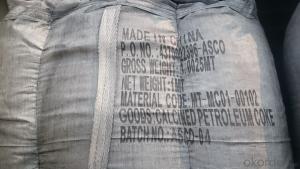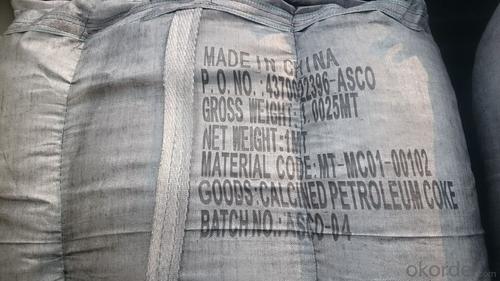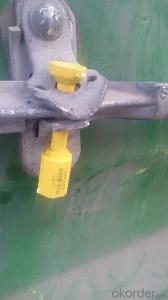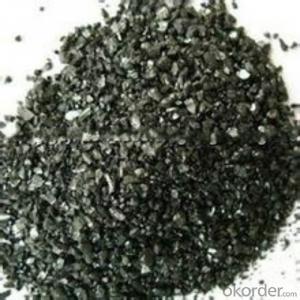GPC with lower Sulphur0.03% max in 1-3mm
- Loading Port:
- Tianjin
- Payment Terms:
- TT OR LC
- Min Order Qty:
- 21 m.t.
- Supply Capability:
- 5000 m.t./month
OKorder Service Pledge
OKorder Financial Service
You Might Also Like
Introduction:
GPC has good characteristics with low ash, low resistivity, low sulphur, high carbon and high density. It is the best material for high quality carbon products. It is used as carbon additive in steel industry or fuel.
Features:
1.Our strong team provide you reliable service that make you feel purchasing is more easier
2. We ensure that we can supply capability with competitive price.
3. Work strictly to guarantee product quality,
4. Highest standard of integrity. Guarantee customer's benefit.
5. Supplying Pet Coke, Met coke, Foundry Coke, Carbon Raiser etc.
Specifications:
F.C.% | 95MIN | 94MIN | 93MIN | 92MIN | 90MIN | 85MIN | 84MIN |
ASH % | 4MAX | 5MAX | 6 MAX | 6.5MAX | 8.5MAX | 12MAX | 13MAX |
V.M.% | 1 MAX | 1MAX | 1.0MAX | 1.5MAX | 1.5MAX | 3 MAX | 3 MAX |
SULFUR % | 0.3MAX | 0.3MAX | 0.3MAX | 0.35MAX | 0.35MAX | 0.5MAX | 0.5MAX |
MOISTURE % | 0.5MAX | 0.5MAX | 0.5MAX | 0.5MAX | 0.5MAX | 1MAX | 1MAX |
Pictures

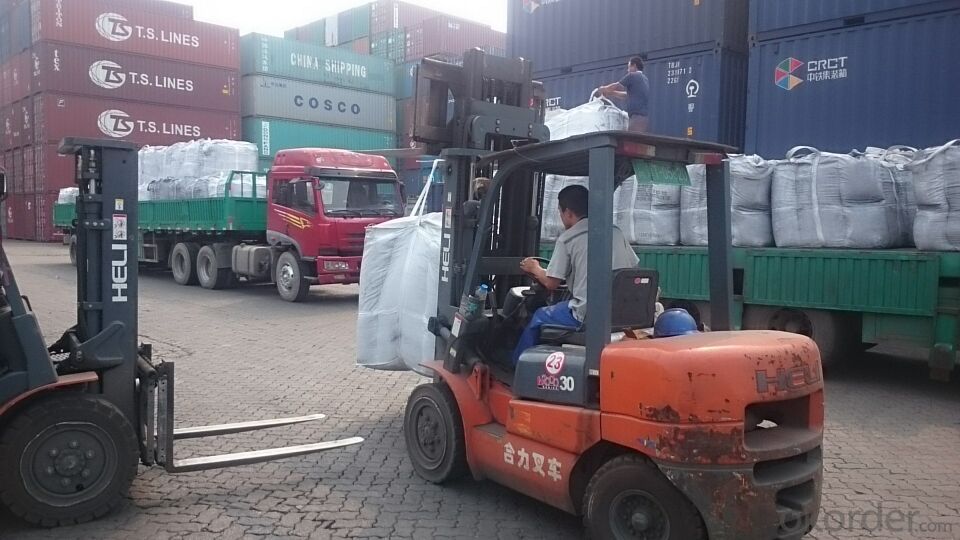
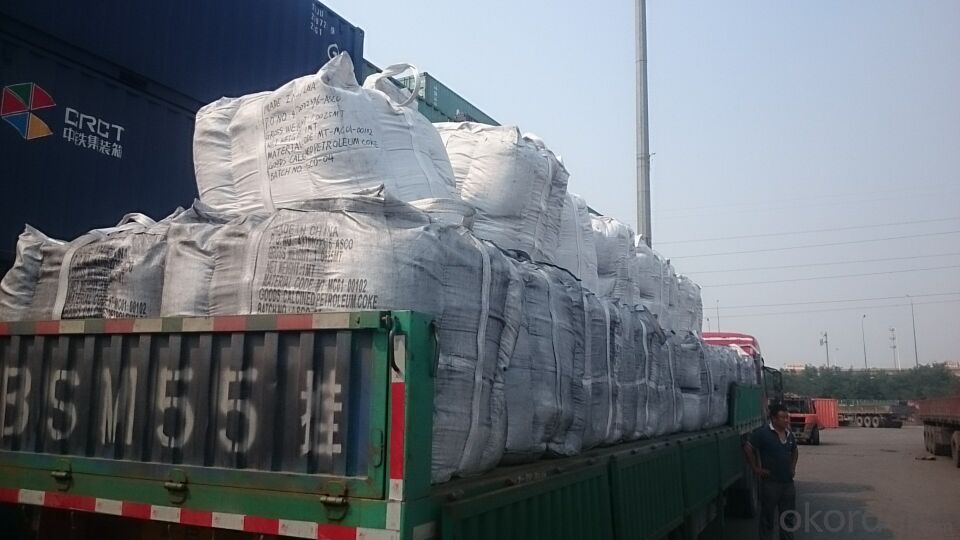
FAQ:
1. Your specification is not very suitable for us.
Please offer us specific indicators by TM or email. We will give you feedback as soon as possible.
2. When can I get the price?
We usually quote within 24 hours after getting your detailed requirements, like size, quantity etc. .
If it is an urgent order, you can call us directly.
3. Do you provide samples?
Yes, samples are available for you to check our quality.
Samples delivery time will be about 3-10 days.
4. What about the lead time for mass product?
The lead time is based on the quantity, about 7-15 days. For graphite product, apply Dual-use items license need about 15-20 working days.
5. What is your terms of delivery?
We accept FOB, CFR, CIF, EXW, etc. You can choose the most convenient way for you. Besides that,
we can also shipping by Air and Express.
6. Product packaging?
We are packed in bulk ship or in ton bag or placing in container or according to your requirements.
7. Notice
please note that the price on Alibaba is a rough price. The actual price will depends on raw materials, exchange rate wage and your order quantity .Hope to cooperation with you, thanks !
- Q: What is the carbon content of different fuels?
- The carbon content of different fuels varies depending on the source and composition of the fuel. Generally, fossil fuels such as coal, oil, and natural gas have high carbon content, with coal having the highest. Renewable fuels like biofuels and biomass also contain carbon, but their carbon content can vary depending on the feedstock and production process. On the other hand, carbon-neutral fuels like hydrogen and electricity have negligible carbon content, as they do not produce carbon dioxide when burned.
- Q: What kinds of barbecue carbon do you have?
- Common carbon on the market are: flammable carbon, charcoal, carbon three mechanisms. Flammable carbon available in outdoor stores, there are two kinds of square and pie. The surface of flammable carbon has a flammable layer, which is easier to ignite than ordinary charcoal.
- Q: What are the impacts of carbon emissions on coral reefs?
- Coral reefs are significantly affected by carbon emissions, with one of the most notable consequences being ocean acidification. This occurs when excess carbon dioxide (CO2) from the atmosphere is absorbed, causing the ocean to become more acidic. As a result, coral reefs struggle to build and maintain their calcium carbonate skeletons, which are crucial for their structure and survival. Consequently, their growth rates decrease, and their resilience weakens, making them more susceptible to damage from storms, disease, and other stressors. Moreover, the increasing ocean temperatures caused by carbon emissions have led to widespread events of coral bleaching. When corals are exposed to prolonged high temperatures, they expel the symbiotic algae (zooxanthellae) that live within their tissues. These algae provide essential nutrients and vibrant colors to the corals. Without them, corals become pale or completely white, a phenomenon known as bleaching. While corals can recover if the stressors decrease, severe or prolonged bleaching can result in coral death and the subsequent degradation of the reef ecosystem. Additionally, carbon emissions contribute to the intensification of storms and other extreme weather events, posing a direct threat to coral reefs. Stronger storms physically damage the reefs, breaking their fragile structures and reducing their resilience. Moreover, the sediment runoff from land, often exacerbated by storms, smothers corals and hinders their ability to feed and grow. The impacts of carbon emissions on coral reefs are not only detrimental to the diverse marine ecosystems but also to the millions of people who rely on them for food, income, and coastal protection. Coral reefs support a wide range of marine life, provide livelihoods for many communities through fishing and tourism, and act as natural barriers against storm surge and coastal erosion. The degradation of coral reefs due to carbon emissions jeopardizes the livelihoods and well-being of these communities, as well as the overall health and biodiversity of our oceans. To address these impacts, it is crucial to reduce carbon emissions by transitioning to cleaner, renewable energy sources, promoting sustainable practices on land to minimize runoff and pollution, and implementing effective management and conservation measures to protect and restore coral reef ecosystems.
- Q: How does carbon affect the stability of ecosystems?
- Carbon plays a crucial role in the stability of ecosystems as it is a key component of all living organisms. It affects stability primarily through the carbon cycle, where it is exchanged between the atmosphere, plants, animals, and soil. Carbon dioxide, a greenhouse gas, regulates the Earth's temperature and climate. Excessive carbon emissions from human activities, such as burning fossil fuels, contribute to climate change, which disrupts ecosystems and poses risks to biodiversity, water resources, and food production. Additionally, carbon is essential for photosynthesis, the process by which plants convert CO2 into oxygen and organic compounds, supporting the entire food chain. Hence, its availability and balance are essential for maintaining the stability and functioning of ecosystems.
- Q: What are the effects of carbon emissions on the stability of mangrove forests?
- Carbon emissions have detrimental effects on the stability of mangrove forests. Increased carbon dioxide in the atmosphere leads to ocean acidification, which negatively impacts mangroves by inhibiting their growth and reducing their ability to survive. Additionally, rising temperatures resulting from carbon emissions contribute to sea level rise, which increases the risk of flooding and erosion in mangrove habitats. This disrupts the delicate balance of the ecosystem and threatens the overall stability and biodiversity of mangrove forests.
- Q: Joint carbide gas incident
- The Central Bureau of investigation in India after the disaster had 12 official allegations, including the Union Carbide (India) Co., Ltd. India 8 executives when he was chairman of Warren Anderson and company, two small companies and the company itself and under the. The 1 indicted India executives have been killed, the court 7 days to negligence causing death sentence the remaining 7 India nationals guilty, including the then Indian president Keshub Mahindra is more than 70 years old, many people. According to the charges, they will be sentenced to two years in prison at most. Survivors of the gas leak and their families and local activists gathered in front of the court 7 days ago, holding banners protesting the punishment of the perpetrators too light and late. Since the conviction was made in a local court in India, the defendant had the right to appeal to a higher court, and it was estimated that the process would continue for several years. After the disaster, Anderson, the American boss of the company, returned home soon. Now he lives in New York. In July last year, the court issued an arrest warrant for Anderson, but it has not been mentioned below.
- Q: What's the difference between blue and red Panasonic batteries (carbon)?
- Blue is leak, proof, general, Purpose, general use battery (leak proof)Red is the long life long life battery (suitable for watches and clocks and other small power appliances)And heavy duty green seems to be good for high power appliances, such as toy cars
- Q: How does carbon affect the formation of toxic algal blooms?
- Toxic algal blooms can be influenced by carbon in both direct and indirect ways. Eutrophication is one direct effect, where carbon, in the form of organic matter, enters water bodies from various human activities. This excess carbon acts as a nutrient for algae, promoting their rapid growth and leading to algal blooms. Another direct effect is the impact of carbon on the composition of algal communities. Certain algae species, known as harmful algal blooms (HABs), can produce toxins that are harmful to aquatic organisms, humans, and animals. The concentration of carbon can influence the growth and dominance of HABs, creating favorable conditions for their development. Furthermore, carbon affects the chemistry of the water, including its pH levels. Changes in pH can significantly affect the physiology and behavior of algae. Some toxic algae species are more tolerant of low pH levels, which can be worsened by increased carbon dioxide levels in the water. This creates an environment that favors the growth of harmful algal blooms. Indirectly, carbon can also impact the temperature and nutrient dynamics in water bodies. Climate change, driven by increased carbon emissions, can result in warmer temperatures, which stimulate algal growth. Additionally, changes in nutrient availability due to carbon-induced alterations in the water cycle can favor the development of toxic algal blooms. In conclusion, carbon plays a significant role in the formation of toxic algal blooms through eutrophication, changes in algal community composition, alterations in water chemistry, and indirect impacts on temperature and nutrient dynamics. Understanding these relationships is crucial for developing strategies to mitigate the occurrence and impact of harmful algal blooms.
- Q: The difference between graphite and carbon
- There are three kinds of carbon allotropes, namely diamond, graphite and amorphous carbon.Graphite is a crystalline mineral of carbonaceous elements, and its crystalline framework is hexagonal layered structure
- Q: What are the effects of carbon emissions on the stability of desertification?
- Carbon emissions contribute to the stability of desertification by exacerbating its effects. Increased atmospheric carbon dioxide levels lead to global warming, which in turn intensifies droughts and reduces precipitation in arid regions. This prolonged dryness accelerates soil degradation, reduces vegetation cover, and undermines the ability of arid ecosystems to sustain life. Therefore, carbon emissions play a significant role in destabilizing desertification processes and further threatening the stability of arid landscapes.
Send your message to us
GPC with lower Sulphur0.03% max in 1-3mm
- Loading Port:
- Tianjin
- Payment Terms:
- TT OR LC
- Min Order Qty:
- 21 m.t.
- Supply Capability:
- 5000 m.t./month
OKorder Service Pledge
OKorder Financial Service
Similar products
Hot products
Hot Searches
